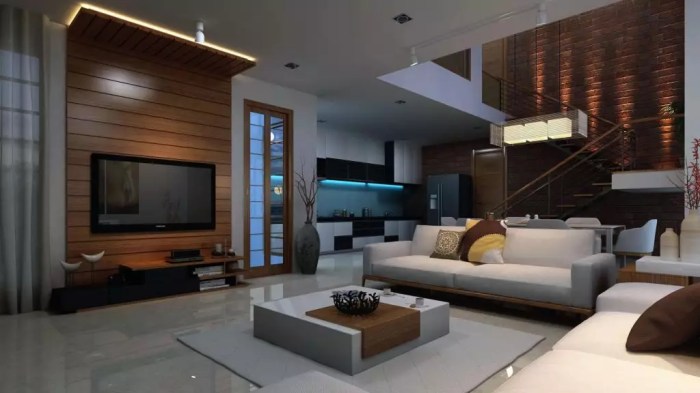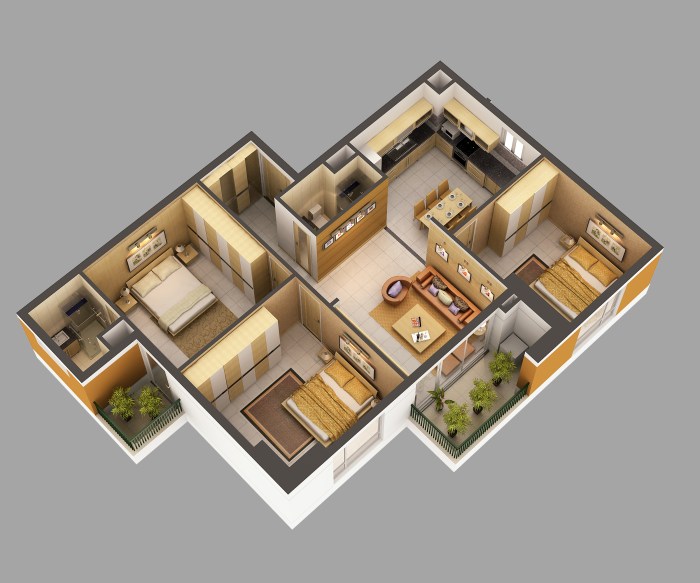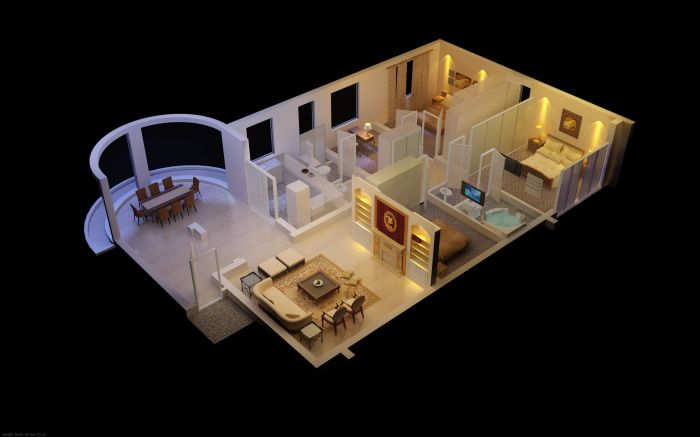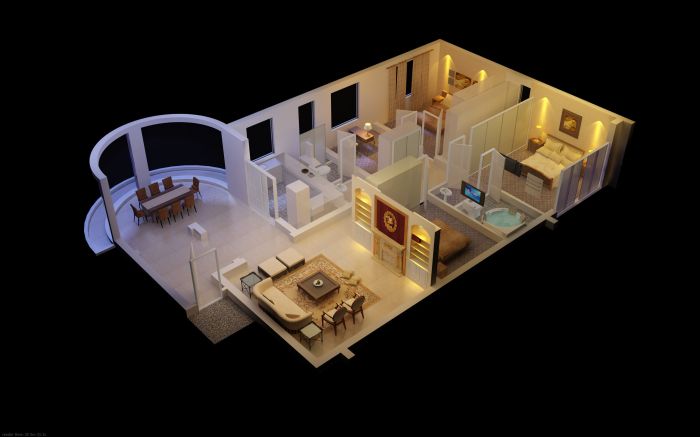3D interior house design has revolutionized the way we imagine and create our living spaces. This technology allows architects, designers, and homeowners to visualize their ideas in a realistic and immersive way, making the design process more collaborative and efficient.
From planning the layout and choosing furniture to selecting materials and colors, 3D design software empowers individuals to bring their dream homes to life before the first brick is laid.
The use of 3D design software has become increasingly popular, offering numerous benefits over traditional methods. With 3D models, you can experience the space as if you were physically present, allowing for a better understanding of the flow, proportions, and overall ambiance.
This interactive experience enables clients and designers to collaborate seamlessly, making adjustments and exploring different possibilities before committing to any final decisions.
Visualization and Presentation Techniques: 3d Interior House Design
Bringing your 3D interior designs to life is essential for captivating clients and conveying your vision effectively. This involves using visualization techniques to create realistic and immersive experiences, allowing clients to truly understand and appreciate your design concepts.
Creating High-Quality Renderings, 3d interior house design
High-quality renderings are crucial for showcasing your designs with precision and detail. Here’s how to achieve them:
- Choose the right rendering software:There are many powerful rendering software options available, each with its strengths and weaknesses. Popular choices include V-Ray, Corona Renderer, and Lumion. The best choice depends on your project’s complexity, desired realism, and your budget.
- Optimize lighting and materials:Realistic lighting and materials are essential for creating believable renderings. Pay close attention to the type, intensity, and direction of light sources. Experiment with different materials and textures to achieve the desired look and feel.
- Use post-processing techniques:Post-processing can enhance the final rendering by adjusting colors, contrast, and sharpness. Tools like Photoshop or After Effects can be used to refine the image and achieve a professional finish.
Creating Engaging Animations
Animations can add a dynamic and engaging element to your presentations, allowing clients to experience the space in a more immersive way.
- Choose the right animation software:Software like 3ds Max, Maya, or Cinema 4D can be used to create high-quality animations. Consider the complexity of the animation and your level of experience when selecting software.
- Plan the camera movements and transitions:The camera’s movement and transitions should be smooth and purposeful, guiding the viewer through the space and highlighting key design elements. Experiment with different camera angles and perspectives to create a compelling narrative.
- Add realistic details and effects:Animations can be enhanced with realistic details like shadows, reflections, and motion blur. These effects contribute to the overall realism and immersive quality of the animation.
Effective Presentation Techniques
Presenting your 3D designs effectively is key to securing client approval.
- Create a compelling storyboard:A storyboard helps you visualize the flow of the presentation, ensuring a clear and logical progression of images and information.
- Use high-resolution images and videos:Ensure your visuals are sharp, clear, and presented in a high-quality format. This demonstrates professionalism and attention to detail.
- Incorporate interactive elements:Interactive elements, such as virtual tours or 360-degree views, can further engage clients and provide a more immersive experience. This allows them to explore the space at their own pace and from different perspectives.
Trends in 3D Interior Design

The field of 3D interior design is constantly evolving, driven by technological advancements, changing lifestyles, and a growing awareness of environmental sustainability. This evolution is reflected in the emergence of new trends that are shaping the way interior spaces are designed and experienced.
Sustainable Materials
The increasing demand for environmentally friendly design practices has led to a surge in the use of sustainable materials in 3D interior design. These materials, sourced from renewable resources or produced using eco-friendly methods, offer a range of benefits, including reduced environmental impact, improved indoor air quality, and enhanced durability.
- Recycled Materials:Recycled materials, such as reclaimed wood, recycled plastic, and upcycled fabrics, offer a sustainable alternative to virgin materials, reducing waste and minimizing environmental impact. For example, reclaimed wood can be used for flooring, furniture, and wall cladding, adding character and sustainability to a space.
- Bio-based Materials:Bio-based materials, derived from renewable plant sources, are gaining popularity in 3D interior design. These materials, such as bamboo, cork, and hemp, are naturally durable, sustainable, and often offer excellent acoustic and thermal insulation properties. Bamboo, for instance, is a rapidly growing grass that can be used for flooring, furniture, and wall panels.
- Low-VOC Paints and Finishes:Low-VOC (Volatile Organic Compound) paints and finishes are becoming increasingly common in interior design. These products emit fewer harmful chemicals into the air, contributing to better indoor air quality and a healthier living environment.
Smart Home Technologies
The integration of smart home technologies is transforming the way we interact with our living spaces, creating more efficient, comfortable, and personalized environments. 3D interior design plays a crucial role in seamlessly integrating these technologies into the design process, ensuring functionality and aesthetic appeal.
- Automated Lighting:Smart lighting systems allow for customized lighting control, adjusting brightness and color temperature based on time of day, mood, or activity. These systems can be integrated into 3D models, enabling designers to visualize the impact of different lighting scenarios on the overall ambiance of a space.
- Smart Appliances:Smart appliances, such as refrigerators, ovens, and washing machines, can be controlled remotely and offer features like energy monitoring and voice control. 3D interior design allows for the strategic placement of these appliances, ensuring both functionality and aesthetic harmony.
- Home Automation Systems:Home automation systems connect and control various smart devices, such as lighting, thermostats, and security systems, through a central hub. 3D models can be used to simulate the functionality of these systems, enabling designers to optimize the user experience.
Collaboration and Communication in 3D Interior Design

In the realm of 3D interior design, effective communication and collaboration are paramount for achieving successful outcomes. A seamless exchange of ideas, preferences, and feedback between designers and clients is crucial for translating visions into tangible spaces.
The Role of 3D Design Software in Communication
D design software plays a pivotal role in facilitating clear communication and feedback between designers and clients. The ability to visualize design concepts in a realistic 3D environment fosters a shared understanding and allows for constructive dialogue throughout the design process.
- Interactive Exploration:3D models allow clients to virtually walk through their future spaces, experiencing the layout, furniture placement, and overall ambiance firsthand. This interactive exploration enables them to identify areas for improvement and provide valuable feedback.
- Visual Feedback:The ability to modify design elements in real-time and see the immediate impact on the 3D model provides clients with a clear visual representation of proposed changes. This visual feedback fosters informed decision-making and eliminates any ambiguity in communication.
- Material and Texture Visualization:3D software allows designers to showcase different materials, finishes, and textures, providing clients with a realistic representation of how their chosen elements will appear in the final space. This enhances the design process by allowing for informed material selections and ensuring that the client’s vision is accurately reflected.
Wrap-Up

3D interior house design has transformed the way we approach home design, empowering both professionals and homeowners to create stunning and functional living spaces. With its ability to bridge the gap between imagination and reality, 3D design software has become an indispensable tool for visualizing, planning, and creating dream homes.
As technology continues to evolve, we can expect even more innovative and immersive experiences that will redefine the future of interior design.
Key Questions Answered
What are the most popular 3D interior design software programs?
Some of the most popular 3D interior design software programs include SketchUp, Autodesk Revit, 3ds Max, Lumion, and Vray.
How much does it cost to hire a 3D interior designer?
The cost of hiring a 3D interior designer can vary depending on the project’s scope, complexity, and the designer’s experience. It’s best to consult with several designers to get a range of estimates.
Can I learn 3D interior design myself?
Yes, there are many online courses and tutorials available that can teach you the basics of 3D interior design. Several software programs offer free trials or introductory versions to get you started.




